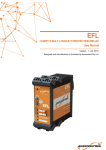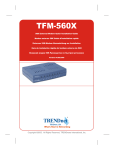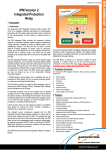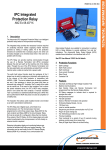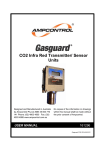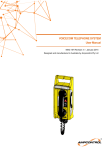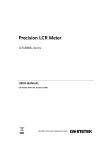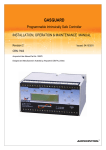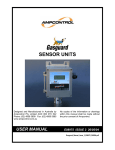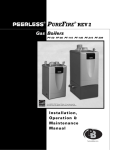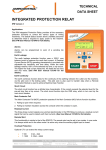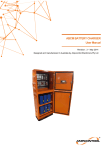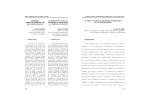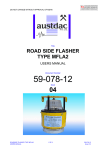Download ipc1 user manual issue 8
Transcript
IPC1 Integrated Protection Relay Designed and Manufactured in Australia by Ampcontrol Pty Limited ACN 000 915 542 Phone: (02) 4903 4800 Fax: (02) 4903 4888 www.ampcontrolgroup.com USER MANUAL No copies of the information or drawings within this manual shall be made without the prior consent of Ampcontrol. 119051 ISSUE 8 20/3/09 IPC1_Manual_Issue_8_ 119051 _200309.pdf IPC1 USER MANUAL ISSUE 8 Copyright Notice No part of this publication may be reproduced, transmitted or transcribed into any language by any means without the express written permission of Ampcontrol Pty Ltd, 7 Billbrooke Close, Cameron Park, N.S.W., 2285, Australia. IPC Software CRN4564 Version IPC1 V01 Initial Release CRN4902 Version IPC1 V02 2002 12/12/02 Change to Relay 3 selection. CRN5103 Disclaimer Version IPC1 V03 2004 23/02/04 Ampcontrol Pty Ltd will make no warranties as to the contents of this documentation and specifically disclaims any implied warranties or fitness for any particular purpose. CRN6244 Ampcontrol further reserves the right to alter the specification of the system and/or manual without obligation to notify any person or organisation of these changes. Before You Begin We would like to take a moment to thank you for purchasing the IPC Integrated Protection Relay. To become completely familiar with this advanced protection and control relay system and to ensure correct operation, we recommend that you take the time to read this user manual thoroughly. MCF_VOLTS_MAX increased to 10% Version IPC1 V04 2007 RTU to Diode Mode, Parameters cleared on change. CRN7597 Version IPC1 V05 2009 Fan Interlock Delay increased IPC1 USER MANUAL ISSUE 8 1. Overview 1.1 1.2 1.2.1 1.2.2 2. 4.2 4.3 4.4 4.5 8. Earth Leakage ............................. 4 Earth Fault Lockout .................... 4 Intrinsically Safe Test ................. 4 Automatic Insulation Test ........... 4 Manual Insulation Test ............... 5 Earth Continuity.......................... 6 Basic Overcurrent Protection Functions..................................... 6 Overcurrent Characteristics ........ 6 Motor Overload Characteristics .. 7 Short Circuit............................... 7 Phase Current balance ................. 8 Main Contactor Fail Protection... 8 Undervoltage Trip ....................... 8 Voltage Metering ........................ 8 Fan Control 6.1 6.2 7. Remote Termination Unit ........... 3 Machine Type Codes .................. 3 Machine Type Number ............... 4 Voltage Related Functions 5.1 5.2 5.3 6. 11. Remote Data Communications ...................... 13 12. Installation & Wiring Instructions................................. 14 11.1 Installation ................................ 14 11.2 Wiring Installation ................... 15 13. Equipment List ......................... 16 14. IPC Specifications ............... 17 15 Trouble Shooting ..................... 18 Current Related Functions 4.1 5. 10. Time & Date ........................ 13 Earth Protection Functions 3.1 3.2 3.2.1 3.2.2 3.2.3 3.3 4. Event Log ............................. 12 Machine Communication 2.1 2.2 2.3 3. Introduction................................. 1 Remote Display Module ............. 1 Trip/Status Messages .................. 2 Last Trip Status Message ............ 2 9. Fan Interlocking .......................... 9 Interlocking Sequence................. 9 16. Drawings IPC-E-001 Typical Connection Diagram ............ 20 IPC-B-002 Display Map ...................................... 21 IPC-B-004 Overcurrent Curves ........................... 22 IPC-B-005 Overload Curves ................................ 23 IPC-B-003 Fan Interlocking System .................... 24 User Adjustable Settings IPC-M-013 IPC Enclosure Dimensions ................ 25 7.1 7.2 IPB-A-021 Remote Termination Unit .................. 26 Parameter Groups ....................... 9 Changing Settings ..................... 10 System Control 8.1 8.2 8.3 8.4 8.5 Digital Inputs ............................ 11 Output Relays ........................... 11 Open Collector Outputs ............ 11 Outlet Control ........................... 11 Operational Sequence ............... 12 IPB-B-010 Remote Display Module RDM-1K ... 27 IPC-A-010 IPC Baseplate Details Including Temporary Locating Pin and Connection Details………………… 28 CONTENTS IPC1 USER MANUAL ISSUE 8 Drawings Continued IPC-A-013 415V Cable Connecting Module........ 29 IPC-A-005 1000V Cable Connecting Module...... 30 IPC-A-008 3.3kV Cable Connecting Module....... 31 IPA-A-033 110V Cable Connecting Module........ 32 IPA-S-005 IPA/IPB Relay/LED Output Module .................................. 33 IPA-A-031 Relay Output Module General Arrangement ......................... 34 IPB-A-029 Relay + Base Installation Drawing……………….. 35 IPC-A-023 IPC Baseplate Details Including Permanent Locating Pin and Connection Details………………… 36 17. Approvals NSW – MDA Ex ia 10035 ANZEx 08.4071X CONTENTS IPC1 USER MANUAL ISSUE 8 Opto Isolated Outputs are available for connection to optional LED or Relay Modules to provide additional “run and trip” indications. The Ampcontrol Relay Output Module (ROU) enables these indications to be interfaced with a PLC. 1. Overview 1.1 Introduction The Ampcontrol IPC Integrated Protection Relay (Version IPC1 V5.0) is an intelligent protection relay based on microprocessor technology. The protection functions provided by the IPC are: Earth Leakage Section 3-1 Earth Fault Lockout Section 3-2 Earth Continuity Section 3-3 Overcurrent/Overload Section 4-0 Short Circuit Section 4-4 Contactor Fail Section 5-1 The integrated relay provides the necessary functions required for protecting electrical outlets supplying underground mining machinery. All of the protection functions are combined into a compact, plug-in unit, which can be easily changed out to minimise down time in the event of a problem with the relay. Protection trips are stored in a non-volatile memory requiring a reset function before power can be restored to the load. This remains the case even if a power down occurs following a trip condition. The IPC Relay can provide machine communication through the use of a Remote Termination Unit (RTU-2) connected between the pilot and earth at the machine end of the trailing cable. Through the use of the RTU-2 Remote Termination Unit the relay parameters are automatically up loaded from a remote machine when a cable is inserted into a power outlet. 1.2 Remote Display Module This module (Ampcontrol RDM-1K) consists of a two line - 16 character LCD display, LED status indicators and a tactile keypad. The earth fault lockout function tests the resistance of the 3 phase lines to earth by applying an intrinsically safe signal prior to the closure of the main contactor in accordance with AS2081.4 1988. The test is initiated once all starting conditions are met. If the resistance is above the preset level then an automatic high voltage DC “Insulation Test” to earth of the cable can be carried out. If the result of the Insulation Test is above the preset resistance level, the IPC’s MCR relay energises, which in turn closes the main contactor. A manual “Insulation Test” is provided as a maintenance/fault finding tool. (When this test is performed the MCR relay does not close at completion of a healthy test). The display level is changed with the Up/Down arrow keys and the Left/Right arrow keys control the display position. The display map (Drawing IPC-B002-21) shows the layout of the various display screens. The module is approved to Ex ia Intrinsic Safety Standards so that it can be installed outside of a flameproof enclosure. The Insulation Test allows cable insulation levels to be trended as an aid to preventative maintenance. 1. IPC Status. 2. Software version and serial number. The IPC Relay has 5 Digital inputs, which feed into a microprocessor unit. The microprocessor has been programmed to control four output relays. Relay MCR for the main contactor and Relay CBR for the circuit breaker. Relay RL3 can be turned off or configured to follow the Fan Interlock Drive output of the IPC Relay. Relay RL4 when closed applies 110V to the CCMC Cable Connecting Module for the Insulation Test. All of the tripping logic and outlet control is performed by the microprocessor, so that virtually no external control is required (See Typical Connection Diagram IPC-E-001, Page 20). 3. Operational information from the protection functions, eg earth leakage current, earth continuity resistance etc. 4. System information including the line voltage and current. 5. Status of digital inputs and relay outputs. 6. Protection trip settings, which can be viewed at any time. Authorised personnel can modify these settings via the RDM, thus eliminating the need to open the flameproof enclosure. 7. Data logging information. The 120 most recent events are logged, with time and date, in a nonvolatile memory, for example power-up, trip, reset, close etc. A review of the first few log events is a useful tool for fault finding. The healthy LED located top centre of the module flashes at 3Hz to indicate healthy communications with the relay. (A flash rate of 1Hz indicates that the module is powered, but is not receiving data). The module displays the following information: Extensive information display and monitoring features are included to facilitate fault finding and system trending. This information can be read locally on the Remote Display Module (RDM-1K) or remotely via a communication link. -1- IPC1 USER MANUAL ISSUE 8 The IPC status display is one of the most useful features of the relay’s display system and should be viewed as the first step in fault finding. The Status display is the default screen on power up and indicates what the IPC Relay requires in order to allow the outlet to close. These messages are useful to unskilled personnel. If more than one message is active the display cycles around all active messages showing them for 1 second each. Message and Type Closing MainCont 2 Through the use of the serial communications port, PLC’s and SCADA Systems can be configured to display the same messages that appear on the Remote Display Module. This helps to provide consistent information to operators. 1.2.1 Trip / Status Messages: The following table shows a list of the twenty-eight (28) status messages and the category (type) of the messages. Messages are cleared according to their message category. Type 1 Messages are cleared by either pressing the <ENT> key while on the Status Display Page or by starting a new starting sequence i.e. EFLO test started. Type 2 Messages are enabled and cleared automatically. Type 3 Messages are triggered by the respective trip functions and are cleared by resetting the trip function. Message and Type Comment Tripped-No Volts 1 MC Close Fail 1 External MC Open 1 Insulation Alarm 1 Last T: --------- 1 Need IPC Start 2 Need RTU Start 2 Outlet Paused 2 Voltage on load side of contactor is too low MCI input did not close within 5 Sec of MCR relay closing IPC detected (via MCI input) that MC was opened – not initiated by the IPC relay Test result at alarm level (1.5 x selected trip level) Shows ‘Last Trip’ record Awaiting IPC start digital input Awaiting RTU start digital input IPC waits 5 Sec between running (or testing) and re-testing . . EFLO Testing 2 Insulat. Testing 2 Manual Ins. Test 2 IPC Memory Error 3 RTU Memory Error 3 Trip-RTU Offline 3 Stopped-RTU PTC 3 Stopped - RTU 3 I Balance Trip 3 Locked Out - Fan 3 Stopped IPC 3 Earth Leak. Trip 3 Earth Cont. Trip 3 E/F Lockout Trip 3 OverCurrent Trip 3 Short Circ. Trip 3 Main Cont. Fail 3 Insulation Fail 3 Running: ----Amps 3 Comment MCR closed, waiting for MCI feedback (5 Sec max) In process of EFLO Test (1 second) In process of Insulation Test (2 seconds) In process of manual Insulation Test Corrupted memory in relay’s stored settings IPC detected errors in set up data received from RTU IPC can’t communicate with RTU RTU PTC input Tripped (open) RTU Stop input Tripped (open) Phase Current Balance Function Tripped Fan interlock system is locking out IPC IPC Stop Digital input activated (closed) Earth leakage Function Tripped Earth Continuity Function Tripped Earth Fault Lockout Function Tripped Over Current Function Tripped Short Circuit Function Tripped Main Contactor Fail Function Tripped Insulation Test Function Tripped Outlet Closed: shows average of 3 phase currents (in amps) Table 1 1.2.2 Last Trip Status Messages: The IPC Relay has several functions, which can stop/trip the outlet and then self-clear. The IPC Relay therefore saves the non-latched trip codes in a register and displays the ‘Last Trip’ messages in the Status Message Page. (Note that the stop/trip function also appears in the Event Log). -2- IPC1 USER MANUAL ISSUE 8 protected in a similar manner to the stop and start circuits. Messages that are displayed at Last T: --------Message EC Leak T EC : Trip Fan I Stop I bal-Trp MC Opened RTU mem. E RTU Off L RTU ptc T Stopped UVOLT Trp Comment If the remote stop, start and PTC functions are not required, each set of terminals must be bridged, or the IPC Relay will not energise. E/C Leakage Trip that provides additional information for E/C Trip E/C Ohms Trip that provides additional information for E/C Trip Fan interlock Stop Current Balance Trip – Differentiates balance trip from basic over current trip Main contactor opened – opening not initiated by the IPC Relay RTU Memory error – Errors in set up data from RTU RTU Off Line – IPC can’t communicate with RTU RTU PTC input tripped IPC Stop Input Tripped Under Voltage trip – voltage on load side too low Four RTD inputs are provided for PT 100 temperature measuring devices. These terminals could also be used with resistor networks to provide digital information back at the IPC Relay. RX, TX and 0V terminals are included for the connection of auxiliary devices such as the RTUCIU1. These terminals allow the input of data from an RS232 source at the load to be transmitted through the pilot of the cable to the IPC Relay’s communication port. On/Off Line Status, machine type, machine number, software version and input status of the Remote Termination Unit can be examined by selecting “Machine Module Information” (Level 2, Positions 1-2). RTD temperature and CIU data is available, Level 2, Position 4-5. 2.2 Machine Type Codes There are 26 selectable machine type codes available for use in the Remote Termination Unit. The descriptive code is transmitted to the IPC Relay to identify the type of machine connected to the outlet. The codes are selected using the Remote Display Module (Level 9, Position 1). 2. Machine Communication 2.1 Remote Termination Unit Belt SHRr S-Ld Hpmp Wpmp cMnr SCar Bk/F Crsh Fan DCB The Remote Termination unit is a microprocessor based fully encapsulated module that replaces the diode at the end of the pilot conductor of the trailing cable. It is powered by and communicates via the pilot line. Its non-volatile memory stores the parameters to configure the outlet as appropriate for that machine. All terminals are fully shrouded, with the pilot and earth terminals being kept segregated from the other terminals. (See RTU-2 General Case Dimensions, Drawing IPB-A-021, Page 26) The Remote Termination Unit (RTU-2) provides remote stop, start facilities of the IPC Relay’s controlled outlet. The circuitry involved for these functions are self-diagnostic and will cause the outlet to turn off if the circuits are earthed or interconnected. This reduces the chance of the outlet operating when not required to do so due to wiring faults. It should be noted that these functions are operational only, and that any emergency stops should be wired direct into the pilot circuit. iFan AFCm AFCt M-BE Bolt HRMr Winc J-bo bBlt Stak aCar PTC terminals are provided for a semiconductor thermistor connection. These terminals are -3- Conveyor Shearer Stage Loader Hydraulic Pump Water Pump Continuous Miner Shuttle Car Breaker Feeder Crusher Fan Distribution Control Box BLANK Fan with interlocking Armoured Face Conveyor Main Gate Armoured Face Conveyor Tail Gate Mobile Boot End Bolter Hard Rock Miner Winch Face Boring Machine Belly Belt Stacker Add-Car IPC1 USER MANUAL ISSUE 8 IGG tBlt Dplg IPC Cable Connection Modules (CCMC) are the preferred modules and must be used when the ‘Insulation Test’ function is required. Inert Gas Generator Transfer belt Dummy plug IPA/IPB Cable Connecting Modules (CCMA) are available for the same rated voltages for use with the IPC Relay. The use of these modules only allows the normal (Intrinsically Safe) EFLO Test to be carried out. The High Voltage DC ‘Insulation Test’ is not available with the CCMA Modules. 2.3 Machine Type Number Machine numbers 1 to 40 can be assigned to machines. These numbers are programmed using the Remote Display Module (Level 9, Position 2). 3. Earth Protection Functions An IPA/IPB CCMA110V Cable Connecting Module is available for use when the relay is installed to control the high-tension supply and/or to provide voltage related functions via 110V PT’s. In this application the EFLO and Insulation test functions are not provided. 3.1 Earth Leakage The earth leakage protection function uses a toroid to measure the earth fault current. This function is certified to AS2081.3 1988. A definite time operating characteristic is provided with adjustable trip sensitivity and an adjustable time delay. When CCM None is selected the IPC Relay does not provide an EFLO or ‘Insulation Test’, or voltage functions. Also under voltage checking does not occur. When a fault occurs and the trip level and time delay are exceeded a trip occurs. The trip acts in the Main Contactor Relay (MCR) logic and is latched. An earth leakage trip is treated as a special fault and requires an authorised person to perform the reset function. This is achieved by operating and holding the lock button closed and then closing the reset button. Note: The ‘CCM None’ and ‘CCMA110V’ Modes MUST NOT BE USED in applications where EFLO is required by mining regulations. 3.2.1 Intrinsically Safe EFLO Test When a trip occurs, the “EL” LED on the remote display module is illuminated and the open collector output on the relay is switched on to provide remote monitoring if required. The initial earth fault lockout function tests the resistance of the 3 phase lines to earth by applying an intrinsically safe signal prior to the closure of the main contactor in accordance with AS2081.4 1988. The test is initiated by closure of the start button once all starting conditions are met (See Section 8.5). This test takes 1 second. The leakage current (EL) is displayed on the RDM “Earth Fault Information” page as a % of the trip level. When the leakage reaches 100% for the selected time delay a trip occurs. If the value is less than the preset level (See Specifications, Page 17) a trip occurs. The “EF” LED on the Remote Display Module is illuminated and the open collector output on the relay is switched on to provide remote monitoring if required. To reset the relay following an earth fault lockout trip, operate the reset button. The trip level is adjustable in 50 mA increments. Range 100 to 500 mA. The time delay is adjustable in 40mS increments. Range, instantaneous <80mS to 470mS. 3.2 Earth Fault Lockout The earth fault leakage level (EF) of the three phases is displayed on the RDM “Earth Fault Information” page as a % of the trip level and relates to the last earth fault lockout test performed The IPC Relay can provide a two-step insulation test as part of the Earth Fault Lockout protection function. The initial test is the mandatory intrinsically safe test and can be followed by an automatic High Voltage ‘Insulation Test’. A manual ‘Insulation Test’ is also provided. 3.2.2 Automatic Insulation Test If a CCMC Mode has been selected, in the Group 1 Settings, an automatic High Voltage DC ‘Insulation Test’ is carried out following a successful Intrinsically Safe Earth Fault Lockout Test (i.e. the resistance is above the preset level selected in the Group 2 Settings Level 9, Position 15). A cable connecting module, which is a resistive isolation device, is used to interface the power conductors to the IPC Relay. Modules are selected in the Group 1 Settings (Level 8, Position 3) for rated line voltages of 110V, 415V, 1000V or 3.3kV. -4- IPC1 USER MANUAL ISSUE 8 guide to confirm that insulation remains above the preset threshold. Insulation tests apart from the generated insulation test via the IPC and CCMC should be still carried out on a regular basis for maintenance purposes. The HV DC ‘Insulation Test’ is initiated when the IPC Relay closes its relay output RL4 for 2 seconds. This applies 110VAC to the CCMC Cable Connecting Module. A HV DC voltage is generated in the CCMC Module, which applies a voltage approaching the peak system voltage between each phase and earth. Trip Setting 0.5 1 2 5 The IPC Relay measures the voltage on the line and calculates the meg-ohm resistance to earth for each phase. At the end of the test the result is stored in the Event Log as ‘it -- . - M:’ If the resistance value is above the preset threshold the MCR Relay picks up allowing the outlet to be energised. Additionally, if the result is equal to or below an Alarm Level (typically 1.5 times the selected trip level, see Table 1) the status message ‘Insulation Alarm’ is displayed on the Status Page (level 0, position 0). The alarm message is displayed until a new EFLO Test is initiated or the <ENT> key is pressed while displaying the alarm message. ‘Insul. Alm’ is also recorded in the Event Log. Actual Fault Resistance (M) Minimum Maximum 0.4 0.6 0.8 1.2 1.6 2.4 4.0 6.4 Table 2 The values in the expected fault resistance range represent ±20% of the nominal value with the exception of the higher end of the 5M range. Trip setting values of 10M and 15M aren’t specified above but are available for configuration within the software. These trip settings of 10M and 15M are not recommended for use by Ampcontrol. Note: Ins . TstT: Selection Alarm Level M: M: 0.1 0.2 0.2 0.3 0.5 0.8 1.0 1.5 2.0 3 5.0 7.5 10 15 15 20 None None Table 1 If the value is less than the preset trip level (0.1 M: to 15 M:) a trip occurs and is latched and saved in a non-volatile memory. The “EF” LED on the Remote Display Module is illuminated and the open collector output on the relay is switched on to provide remote monitoring if required. An Insulation Trip shares the “EF” LED on the Remote Display Module with an EFLO trip but has dedicated trip messages on the Status Page. To reset the relay following an insulation test fail trip, operate the reset button. That the start input must be held closed for the duration of the test. The recommended trip setting values to be utilised for the insulation test trip settings are to be less than 5M. To obtain optimum results the 2M trip setting is recommended. 3.2.3 Manual Insulation Test A manual “Insulation Test” is provided as a maintenance/fault finding tool. The manual test can only be carried out when the load is not energized. When this test is performed the MCR relay is prevented from closing at the completion of a healthy test. Before a manual Insulation Test can be performed the following conditions must apply: 1. 2. At the completion of a test the leakage level for each phase is retained in memory until the next test is carried out. This can be viewed on the Remote Display Module RDM (Level 3, Position 3). 3. 4. 5. 6. 7. 8. If the ‘Insulation Test’ is not selected by either not selecting CCMC or setting ‘Ins.TstT:’ value to ‘None’ then the MCR Relay closes at the completion of a healthy EFLO Test. The Remote Display Module must be online with the Insulation Test page being displayed. This is located on the ‘EARTH FAULT INFORMATION’ Page, level 3, position 2. Pilot must be healthy (and any previous trips reset). EFLO function must not be tripped. Insulation Test function must not be tripped. Outlet must not be running. Outlet must not be in the process of ‘closing’. Outlet must not be ‘Paused’ The ‘Lock’ digital input must be closed. When the above conditions are met the <ENT> key must be pressed and held (for the duration of the test). After 3 seconds the EFLO test will commence. If the test result is healthy the manual insulation test is initiated. The test voltage is applied to the outgoing feeder while ever the above The accuracy of the insulation test and expected trip ranges are outlined in the table below. The results from insulation test should only be used as a -5- IPC1 USER MANUAL ISSUE 8 or “Pilot Latch: Off” (Level 9, Position 11). To manually reset the relay, operate the reset button. conditions are held (including holding the <ENT> key). The test results are continuously calculated and displayed. The operator should maintain the test at least long enough for the readings to stabilize, this being a function of the cable length. Once the test is completed (usually by releasing the <ENT> key) the results are held in memory until another insulation test is commenced either manually or as part of the starting sequence, or IPC control power is lost. The “EC” LED on the Remote Display Module is illuminated and the open collector output on the relay is switched on to provide remote monitoring if required. The earth continuity resistance (ECR) of the pilot – earth loop and the leakage (L) between the pilot and earth conductors is displayed on the RDM “Earth Fault Information” page as a % of the trip levels. When either value reaches 100% a trip occurs. Note that the manual test can be carried out even if the ‘Ins.TstT:’ selection is set to ‘none’ (ie the automatic insulation test in the starting sequence is turned off). If the ‘CCM’ selection (see section 3.2) is not a CCMC Cable Connecting Module, then the manual test will only perform an EFLO test. Pilot Trip Time is adjustable to allow for operation in noisy electrical environments. The following trip times are available: 80, 120, 160, 200, 300, 400 and 500mS The status of the manual insulation test is shown on the Insulation Test Information Page (level 3, position 3). A single letter following ‘Mt:’ indicates the status of the test: Mt:x : Manual Test is blocked - by any one or more of the conditions 1 to 8 above. Mt:e : Only the <ENT> key is required to initiate the manual test. Mt:t : The manual test is timing through the enabling period (3 seconds). Mt:A : The manual test is Active. The display will show measured values. A setting of 120mS should be suitable for most installations. Long time delays (>200 ms) should only be used where necessary. Consequence of long trip times should be thoroughly assessed from a safety point of view before using the higher values. 4. Current Related Functions 4.1 Basic Overcurrent Protection Functions Two current transformers are used to measure the three line currents. The measured currents are used to implement the following protection functions: (a) Overcurrent or Motor Overload (b) Short Circuit (c) Phase Current Balance 3.3 Earth Continuity The earth continuity function tests for the continuity of the earthing between the outlet and the machine, via the pilot core in the trailing cable. This is in accordance with AS2081.2 1988. The pilot core is also used to transfer data when a Remote Termination Unit is used to achieve machine communication. Full load settings cover a range from 7.5 Amps to 464 Amps. A current range and current multiplier are utilised to select and store the full load current value in the non-volatile memory. This forms the basic reference level for the overcurrent protection functions. The IPC relay can be configured to operate in either diode or RTU mode. The mode is selected in “Pilot Type”, (Level 8, Position 1) and determines what terminating device the relay is looking for on the pilot. The current range is selectable in 4 Amp increments between 60 and 116 Amps. The current multiplier is selectable at 1/8, 1/4, 1/2, 1, 2, 4 times. (See Section 7.1) Note: The Remote Termination Unit will only be recognised by an IPC Relay and will not be seen as a diode by other earth continuity devices. Example - Overcurrent Setting To obtain a full load current of 152 Amps select a current range of 76 Amps and a multiplier of 2. The relay measures the resistance of the pilot earth loop and the leakage between the pilot and earth conductors. The leakage measurement ensures that pilot to earth faults are detected. If the pilot earth loop is not healthy a trip occurs (See Specifications, Page 17) which in turn opens the main contactor control circuit. The fault can be configured as latching or non-latching. This allows the user to determine if the fault is manually or automatically reset once the pilot - earth loop is healthy. The selection is either “Pilot Latch: On” Two curve types can be selected and a time multiplier modifies the basic trip time characteristic. There are eighteen (18) multiplier settings that can be selected ranging from 0.005 times to 1.0 times (See Section 7.1). It should be noted that settings 0.005, 0.01, 0.015, 0.02, 0.03 and 0.04 are positioned after setting 1.0 in the stored setting’s list (Level 9, Position 4). -6- IPC1 USER MANUAL ISSUE 8 Thermal Model The instantaneous current in each of the three phases can be displayed on the RDM (Level 5, Position 1). The three phase currents are displayed, as a % of the overload set current. The average current value is expressed in Amps and is displayed at Level 5 and the Status Page (Level 0, Position 0). Thermal modeling is based on a thermal time constant of 30 minutes (time multiplier setting of 1.0 times). The time multiplier can reduce this value to a minimum thermal time constant of 1.5 minutes (time multiplier setting of 0.05 times). The three measured phase currents are squared and added together to provide the heating input into the thermal model. Following a trip condition the following conditions must be met to achieve a reset: a) The IPC reset input must be closed b) The trip accumulator must be less than 80% While the main contactor is closed, the cooling output from the thermal model is calculated to achieve the necessary time constants. When the main contactor is open a “Cooling Multiplier” is used to modify the basic time constant. This can be used to account for the reduced cooling capacity while the motor is not running (when applicable). This multiplier is selectable at 0.2, 0.3, 0.4, 0.5, 0.8, 1.0, 2, 5, 10, 20, and 50 times. 4.2 Overcurrent Characteristic If the selected overcurrent type is “vInv”, then a very inverse overcurrent characteristic set of curves are available for selection. (See “vInv” Curves, Drawing IPB-B-004, Page 22). The three phase currents are compared and the highest current is used to calculate the trip time. If the current exceeds the selected full load current an “overcurrent trip accumulator” increases at a rate determined by the current and the selected curve. This can be displayed on the RDM (Level 5, Position 2). When the current falls below the selected full load current the trip accumulator reduces towards zero rapidly, however, if the overcurrent condition persists so that the trip accumulator reaches 100% then a trip occurs. If viewed during start up the trip accumulator can help determine if overcurrent settings are correct. A selection of 1.0 times sets the motor off cooling rate equal to motor running cooling rate. This selection is appropriate where cooling is maintained even when the motor is stopped, eg water cooled motors. When 0.2 times is selected the motor off cooling rate is reduced to 20% of the motor running cooling rate. A selection of 50 times effectively disables the thermal memory. With this selection, as soon as the main contactor opens, the thermal model resets quickly so that a cold restart is achieved. If a trip occurs the “OC” LED on the Remote Display Module is illuminated and the open collector output on the relay is switched on to provide remote monitoring if required. Caution: Repeated restart attempts in this condition may damage the motor. To reset the relay following an overcurrent trip, operate the reset button. Typical fan cooled motor protection is based on a setting of 0.4, however, for the best protection consult your motor manufacturer. 4.3 Motor Overload Characteristic The overcurrent type “m-OL” is used when a motor overload characteristic is required (See “m-OL” Curves, Drawing IPB-B-005, Page 23). This characteristic uses a thermal model of the motor to determine the tripping characteristic. The motor overload curves are shown for both cold and hot conditions. The hot curve corresponds to the trip time after the motor has been running at the selected full load current indefinitely. The thermal model continues to simulate the motors thermal behaviour even if the power is removed from the relay. When power is restored the thermal memory would be at the same level had there been no loss of power. The “OC Trip” Accumulator shows the state of the thermal model: 0% = Cold, 100% = Trip. When a trip occurs the IPC Relay cannot be reset, by operation of the reset button, until the accumulator is less than 80%. In order that an emergency restart on a hot motor can be achieved a reset of the thermal memory is possible by selecting Level 5, Position 3 on the Remote Display Module. The display shows: The motor manufacturer’s data should be consulted to select the time multiplier appropriate for the motor being protected. Typically, the capacity of a cold motor is given at six times its rated current. The IPC trip curves can be used to select the time multiplier, which best suits the motors overload capacity. -7- IPC1 USER MANUAL ISSUE 8 ZERO THERM MEM? RESET + LOCK[100] The phase current balance protection is inhibited until the average current exceeds both 20% of the selected full load current and the selected balance trip level. The [100] indicates the current value of the trip accumulator. Operating the lock and reset buttons simultaneously while the above display is being shown will zero the OC Trip Accumulator after 1.5 seconds. If the trip level is exceeded, a timer is triggered. If the imbalance remains above the set level for more than two seconds the relay trips. The event log records “Ibal” to differentiate it from a true overcurrent trip. Indication of the trip condition for motor overload is the same that occurs for an overcurrent trip. The status of the timer is displayed adjacent to the “Ibal” value (Level 5, Position 2). A trip condition occurs when the timer reaches 100%. 4.4 Short Circuit The short circuit function has a definite time characteristic. If the current exceeds the selected level for the pre-set time then a trip occurs. 5. Voltage Related Functions The “SC” LED on the Remote Display Module is illuminated and the open collector output on the relay is switched on to provide monitoring if required. The Main Contactor Fail (MCF) protection operates if the Main Contactor (MC) fails to function by either: 5.1 Main Contactor Fail Protection 1. To reset the relay following a short circuit trip it is necessary to operate and hold the lock button closed and then close the reset button. 2. The relay can be programmed so that a short circuit condition can trip either the “CBR” relay or the “MCR relay. This can be achieved by selecting either relay at the “SC Relay” selection in the nonvolatile memory (Level 8, Position 5) on the Remote Display Module. Normally the “CBR” selection would be used. If “MCR” is selected then the user must ensure that the interrupting device that is operated by the short circuit trip output of the relay has sufficient current interrupting capacity at the system voltage for the situation in which it is installed. This test provides “Loss of Vacuum Protection”. This function is inhibited immediately after the main contactor opens to allow for back EMF voltages generated by some motors to dissipate. The inbuilt time is adjustable from 2 to 20 seconds (See Section 7.1). The short circuit trip level is adjustable from 3 to 10 times (full load current) in 0.5 increments. The trip time is selectable from 20 to 160mS. A main contactor fail trip causes the CBR relay to de-energise, which trips the circuit breaker. An internal battery backed flag in the IPC Relay is also tripped. A LED on the front panel of the IPC Relay begins to flash. 4.5 Phase Current Balance Phase current balance protection is selected via the “Cur Bal Trp” selection (See Section 7.1). The current balance measurement is displayed on the Remote Display Module and is calculated as: Ibal = Iave = MAX ' I = Failing to open when required. This is achieved by comparing the state of the main contactor (via the Main Contactor Input MCI) against the state of the MCR relay output. This test provides “Frozen Contactor Protection”. Failing to maintain insulation across the contacts when the contactor is open. The Cable Connecting Module is used to measure the voltage on the load side of the contactor. If this exceeds 10% of the rated line voltage, a trip will occur. The “MCF” LED on the Remote Display Module is illuminated and the open collector output on the relay is switched on to provide remote monitoring if required. MAX ' I x 100% Iave Average of the 3 phase currents To reset the flag, access to the relay is necessary. In the case of flameproof equipment the power has to be removed in accordance with AS1039. The reset button is accessible through the front fascia of the relay and must be pressed for 1 second. The maximum deviation of a phase current from the average The trip level is selectable at 5%, 10%, 20%, 50% and off. -8- IPC1 USER MANUAL ISSUE 8 Each relay has the ability to read and drive the FIO link via the Fan Input Read (FIR) processor input and the Fan Interlock Drive (FID) processor output. The status of the input/output can be viewed on the Remote Display Module - “Relay and Digital Input Status” Section (Level 6, Position 4). 5.2 Undervoltage Trip Undervoltage protection is enabled as soon as the main contactor is closed (indicated by closing the MCI input). If any of the phase voltages drop below the selected trip setting of the nominal line voltage for 800mSec then the outlet is stopped. This is recorded in the event log as “uVOLT Trp”. The outlet control in each IPC Relay has been designed so that an outlet will not run unless either: The trip level is selectable from 20% to 80% in 10% increments (Level 8, Position 4) on the Remote Display Module. (a) The FIR input is “ON”, or (b) The Remote Termination Unit connected to that IPC has been programmed with machine type “iFan”. 5.3 Voltage Metering The cable connecting interface module (CCMC/CCMA) is also used to provide line voltage metering. The result of these conditions is reflected in an internal Fan Run Status (FRS) bit. The status of this can be viewed on the Remote Display Module. If the FRS is on, then the fan interlocking system will allow the associated outlet to run. The outgoing line voltages for each of the 3 phases are displayed as a % of the selected rated line voltage on the Remote Display Module (Level 4, Position 1). The maximum reading is 120% Relay 3 can be selected to be either non-functional (off) or can be configured to follow the Fan Interlock Drive (FID) or Fan Interlock Read (FIR) outputs of the Relay. Line voltages from 415V, 1000V, 3300V or 110V are configured when the appropriate CCMC/CCMA Cable Connecting Module is selected in the Group 1 Settings (Level 8, Position 4) on the Remote Display Module. This parameter is also used in determining the cable fault leakage levels. For single fan operation select FID or FIR. Relay 3 will energises as soon as current is above the preselected threshold. If FID is selected for dual fan operation then Relay 3 will energise as soon as current from either fan is above the preselected threshold. If FIR is selected Relay 3 will only energise if the current from both fans are above the preselected threshold. 6. Fan Control 6.1 Fan Interlocking A fan interlocking facility can be selected to prevent outlets from being energised until a mine section ventilation fan is operational. This facility eliminates the need for dedicated outlets. The configuration of the fan interlocking system is shown on Drawing IPB-B-002, Page 24. 6.2 Interlocking Sequence The fan interlocking operates as follows: 1. Each IPC powers up with the FID output turned off. At this point the FIR input on all IPC Relays will read, as off, therefore no outlet will run. 2. When a machine is plugged into an outlet that has its Remote Termination Unit programmed “iFan” then that relay will be allowed to run when requested. (Provided there are no protection trips, stops etc preventing its operation). 3. When that outlet is running and the current is above the preselected current threshold, a 5 second time delay is initiated. At the completion of this delay, that IPC Relay turns on its FID output. The fan current threshold is adjustable from 32% to 96% of full load current in 8% increments (See Section 7.1). 4. Detecting the interlocking signal via their FIR inputs then enables all other IPC Relays on the FIO link. Each relay is linked together via the “FIO” (Fan Interlock Input/Output Terminal). For single fan operation a 100 : resistor is connected between this link and earth. This causes all relays in the system to default to a “Slave” mode waiting to receive an interlocking signal before they can run. For dual fan operation it is necessary to connect two 100: resistors in parallel to the FIO Terminal, otherwise all FIR Inputs will read as off and the slave outlets will not run. When an IPC Relay detects a Remote Termination Unit that has been programmed with the special machine type identifier “iFan” that particular relay switches to a “Master” configuration. This relay controls the slave outlets allowing them to run when the fan current is above the selected threshold setting. -9- IPC1 USER MANUAL ISSUE 8 5. “switched”. If a diode pilot mode is selected the IPC Relay reads and writes to and from the relay’s internal memory for the group 2 settings. If at any stage the fan current drops below the threshold, or the fan is stopped, the master IPC Relay turns off the FID output. This causes all slave IPC Relays to stop. If a RTU Mode is selected the settings are sent to and retrieved from the memory in the Remote Termination Unit. If fan interlocking is not required, the system can be disabled by connecting a 10k:/1W resistor from the FIO Terminal (Terminal 9) to OV (Terminal 12) on each relay. In this case the FIO Terminals are not interlinked. This causes the FIR inputs to read high at all times. An auxiliary fan being used in this situation would have its Remote Termination Unit programmed with machine type “Fan”. 7. Adjustable Settings 7.1 Parameter Groups There are two groups of adjustable settings contained in the IPC Relay’s non-volatile memory. Both groups can be viewed and modified via the Remote Display Module. The first group of settings is always stored in the relay and relates to parameters, which are linked to the system rather than the particular load connected to the outlet. Group 2 Settings: Group 1 Settings: Pilot Mode: Determines if the pilot is to be terminated with a diode or remote termination unit EL Time: Sets the trip time for the earth leakage protection EL Sens: Sets the sensitivity trip level for the earth leakage protection EFLO: Figure 1 RTU MC Type: Selects the RTU descriptive code transmitted to identify the machine connected to the outlet. RTU MC No: Selects the assigned machine number to be transmitted by the Remote termination Unit. OC I range: Sets the basic current range Selects the Cable Connection module to be used with the IPC Relay OC I mul: Combines with OC range to define the full load current U/V Trip: Selects the undervoltage threshold as a % of line volts trip OC Type: Selects either very inverse overcurrent or motor overload protection SC Relay: Selects which output relay (MCR or CBR) is tripped in event of a short circuit trip OC t mul: Modifies the basic overcurrent time curves to achieve the desired trip times Cool mul: Allows the cooling rate of the thermal model to be modified Cur Bal Trp: Adjusts current phase balance trip SC I trip: Sets the short circuit trip level SC Trip t: Sets the trip time for the short circuit function EC Time: Relay 3: Sets the trip time for the earth continuity protection Selects “off”, “FID” or “FIR” operation of the relay The second group of settings consists of parameters that are related to the load connected to the protected outlet. These settings are stored, retrieved to/from the memory in the IPC Relay or the memory in the Remote Termination Unit, depending on the “Pilot Mode” setting. Figure 1 shows how the memory is -10- IPC1 USER MANUAL ISSUE 8 Pilot Latch: Determines whether earth continuity trips are self resetting or not When changes have been made to the stored values, the old value and the new value are stored in the event log. B-emf TIME: Adjustable time delay to inhibit main contactor fail following opening of main contactor A separate log immediately proceeds this recording the time and date that the change was made. Fan i Level: Sets the fan current threshold at which other outlets are allowed to run Remote Start: When “Yes” is selected the IPC Relay ignores the local start input. When “No” is selected the local start/stop inputs control the relay Ins . TstT: Sets the trip threshold or disables the function Note 1 While in the diode mode the IPC Relay can be preset with operating values in the Group 2 memory prior to switching to the RTU mode. When in this mode the relay uses the Remote Termination Unit settings. If the Remote Termination Unit is replaced with a diode and the “Pilot Mode” switched back to diode, the settings will revert back to the values preset in the IPC Relay. Note 2 When the relay has been selected for RTU Mode the RTU must be on line before the RTU set up mode can be entered. 7.2 Changing Settings The procedure for adjusting the settings is independent of where the values are stored. The pilot mode should be checked prior to making any other adjustments to be certain the changes are made to the desired memory. 8. System Control 8.1 Digital Inputs The IPC Relay has five digital inputs, which are all voltage free contact inputs. Shorting the two input terminals together activates them. The inputs are MCI, start, stop, lock and reset. 1. Ensure the outlet is stopped. 2. For Group 2 Settings in RTU Mode, ensure RTU is on line. 3. Display the parameter that has to be changed on the Remote Display Module’s liquid crystal display. 4. Momentarily operate the lock push button. A warning message appears. Press the enter button to acknowledge the warning message and to confirm that a change is desired. The IPC Relay has output relays to control the main contactor (MCR) and the circuit breaker (CBR). Both relays are fail safe with respect to power supply loss and are controlled on the basis of protection functions. Use the left and right arrows to step through the allowable values until the desired new setting is displayed. If the right arrow key is pressed when viewing the last parameter the display wraps back around to show the first parameter. Relay 3 has a selective function. (See section 6.1). RL4 applies 110V for the Insulation Test. (See section 3.2.2). The status of inputs can be displayed on the Remote Display Module (Level 6, Positions 2 and 3). 8.2 Output Relays 5. 6. 7. 8. The status of the relays can be displayed on the Remote Display Module (Level 6, Position 1). Press the enter button to indicate that the value is the required setting. 8.3 Open Collector Outputs The IPC Relay has eight open collector outputs, which are driven through opto couplers to provide additional indication if required. These can be used to drive LED’s, or additional relays (with appropriate drive circuitry). The eight outputs correspond to the LED’s on the display module, turning on whenever the corresponding LED is flashing. The signals are available on the IPC Relay’s base pins 35-42, and the common is on pin 34. Momentarily operate the lock push button. The display will show a confirming message, then return to the viewing level. If the up or down keys are operated during the procedure the IPC Relay aborts the modifying sequence. -11- IPC1 USER MANUAL ISSUE 8 Contact Ampcontrol if further information is required about these outputs. A time delay of 5 seconds is allowed for the Main Contactor Interlock (MCI) to close. If it does not close within this time, then the run mode is exited. 8.4 Outlet Control The outlet can be energised by local or remote operation depending on the “Remote Start” option. The selection is “Yes” or “No” (Level 9, Position 14). If a stop input is closed while the relay is in run mode, the run is cleared, and the MCR relay deenergises. The event log reads “Stopped”. If a stop input is closed during a cable fault lockout test, then the test is aborted. RTU Mode: If “Yes” is selected the relay ignores the local start input thus allowing operation of the outlet from the remote machine. Both the remote and local stop buttons will turn off the outlet. While the main contactor is closed, the MCI input is continuously monitored. If it opens, the run is cleared and the MCR relay de-energises. In this case the event log records “MC Opened” which indicates that the outlet was turned off by something other than the IPC Relay, eg open circuited main contactor coil or control supply. If “No” is selected the local start/stop buttons control the outlet. The Remote Termination Unit’s start, stop and PTC terminals must be bridged to energise the outlet . It should be noted that if the main contactor does not close when the MCR relay closes and the start/stop conditions are maintained, then the IPC will cycle through the following start sequence: testing, run, stopped, pause then repeat the sequence while ever the start input is closed. Remote Operation in Diode Mode: In this mode the stop/start station is connected in the pilot. (See Typical Connection Diagram IPC-E-001, Page 20). The pilot has a hysteresis of 100 ohms. This is to allow a 100 ohm resistor to be connected across the start button. The hysteresis is linked to the main contactor input (MCI). If MCI is open, then the earth continuity will trip at 45 ohms. If the MCI is closed, the earth continuity trips at 145 ohms. 9. Event Log A real time clock/calendar is included in the IPC Relay. This combines with the non-volatile memory to provide a data-logging feature. This log sequentially records the time, date and details of the most recent event. A chronological list of the previous 120 events is stored. It is also necessary to bridge the local start button or start input on the relay, on the outlet controlled by this method. Both the remote and local stop buttons will turn off the outlet. Stop/Start functions are operational only. Emergency stops should be wired direct into the pilot circuit. The event log can be automatically scrolled so as to view the entire log. To achieve this press “Enter” followed by the “Right or Left” arrow keys to commence the scroll. The log will scroll one log per second in the direction of the arrow key pressed. Press “Enter” to stop the scroll at the desired log. 8.5 Operational Sequence A typical display shows: Before an outlet can be energised the following conditions must apply: (a) (b) (c) (d) (e) LOG 10: EL TRIP MO 15/05 09:46:21 No protection faults present Fan interlocking enabled Stop input open Local and remote start inputs closed RTU stop and PTC inputs closed This records that an earth leakage fault caused a trip condition on Monday, 15 May at 9.46am. Log 10 indicates that it is the 10th log in the list. Log 1 is always the most recent event. Each time a new log is recorded, the 120th log is removed from the list. Once these conditions are obtained a cable fault lock out test is performed automatically. This takes 1 second. If the result of this test is satisfactory the IPC Relay goes into the run mode and the MCR relay picks up. The following events are logged: The “RUN” LED on the Remote Display Module is illuminated and the open collector output on the relay is switched on to provide remote monitoring if required. -12- Power Up The instant that power is applied to the relay Pwr Down Removal of power from the relay IPC1 USER MANUAL ISSUE 8 Mem.ERROR Records that the relay’s nonvolatile parameter memory has been corrupted Internal microprocessor reset MCR Close Closure of the Main Contactor Relay Stopped Stopping of the outlet by operation of the local stop button Tmem Loss The thermal memory data has been corrupted Stopping of the outlet by operation of the remote stop button RTU mem. E Records that the remote termination unit’s non-volatile memory has been corrupted or remote termination unit has gone off line while the outlet is running. Outlet On Records RTU machine code and number when main contactor is closed (proceeded by MCR closed). This log only appears when in RTU mode. RTU Off L Indicates a loss of communications with the RTU. Meg : Trp Insulation Test failed IT: -- . -M: Records the result of the Insulation Test Insul . Alm Result of Insulation Test is equal to or less than the alarm level P- P reset RTU Stop MC Opened Main Contactor has opened but not initiated by the IPC Relay MC Fail Main Contactor Fail Function Trip CloseFail Indicates that the MCI Input did not close within 5 seconds of MCR closing EC : Trip Pilot/Earth continuity loop exceeds 45 Ohms EC Leak T Leakage resistance between the pilot and earth is less than 1500 Ohms EL Trip Earth leakage protection tripped EFLR Fail Earth fault lock out test has failed SC Trip Trip condition of short circuit protection OC Trip Trip condition of overcurrent or overload protection I bal-Trp Current balance trip condition RESET Records resetting of a protection trip function Setup Mod Records that set up data has been modified 10. Time & Date If there is a need to adjust the real time clock, carry out the following procedure: 1. Fan I Stp Outlet stopped by fan interlock uVOLT Trp Records that voltage was not present on at least one outgoing phase when the main contactor was closed MCF F Trp Internal battery contactor fail trip RTU ptc T Operation of the termination units PTC T-mem Rst Thermal memory has manually reset to zero backed Using the Remote Display Module select the time and date information page (Level 7, Position 1) to display the Day, Month, Year, Hours and Minutes. ------------MO 150595 09:46 2. Press the enter key. A “v” will appear in the top line above the minute section. This indicates the number to be changed. 3. Use the left and right arrow keys to move the “v” to the desired position. 4. Press the enter key. The “v” now changes to a “?” The right arrow key is used to increment the allowable values, once the desired value is obtained, press the enter key again. The “?” returns to a “v”. 5. Repeat steps 3 and 4 until the correct time and date is displayed. main remote been -13- IPC1 USER MANUAL ISSUE 8 6. With the “v” showing press the lock push button. The “v” then changes to “E”. (This is a prompt to press the enter key). 7. Press the enter key. At that instant, the seconds are zeroed and the selected time/date information is transferred to the internal clock. The relay is designed to operate when mounted either laid down flat or in a vertical position. Vent holes are provided at both the top and bottom of the relay to assist in the cooling of the electronics inside the relay. These vents should not be blocked or restricted in any way. When installing the IPC Relay care should be taken to ensure sufficient space is allowed around the relay for the ease of change out during routine maintenance. If the battery voltage is low the time will zero and the date will reset to 1st January on power up. If the battery is flat or faulty the relay is likely to trip on main contactor fail on power up. Connections to the IPC Relay are made via a plug in base. This base is to be securely fastened to the enclosure in which it is being installed. The base is clearly labelled for ease of terminal location and identification. The base sockets are factory adjusted so that they are able to move to assist in alignment when the relay is inserted. Do not tighten socket mounting screws. For installation mounting see drawing IPBA029 (Page 35) Note: The date and time are used only to time stamp the events in the log (which are recorded sequentially regardless of the date/time). Date and time data is not used for any control functions. 11. Remote Data Communications The IPC Integrated Protection Relay has the facility for connecting remote monitoring equipment. This can be in the form of either the Remote Display Module or other peripheral equipment such as PLC’s. (B) Remote Display Module (RDM) The Remote Display Module is an intrinsically safe device (Ex ia), designed to be mounted into the cut out of an IP54 enclosure and can therefore be mounted external to the switchgear it is controlling. To provide maximum benefit to the operator, one RDM is normally used per relay. This allows information from several relays to be simultaneously accessed and compared. However, if space restrictions preclude this, a compromise is to use one (1) RDM to monitor and control more than one IPC Relay. In these circumstances the following wiring arrangement is recommended: For PLC applications each integrated protection relay is connected to a Serial Interface Module (IPSI), which has its output drop connected to a DNET-IP2 Protocol Converter. The Protocol Converter provides the communications link to a PLC (See User Manual E06510 for further details). The Ampcontrol DNET-IP2 Serial Communication System transfers data and commands between the Host System and the modules using RS232, RS422 and RS485 protocols. 12. Installation & Wiring Instructions IPB1 The IPC Integrated Protection Relay is a microprocessor based protection relay that has the facility for connecting intrinsically safe remote monitoring equipment. This can be in the form of either the Remote Display Module or other peripheral equipment such as PLC’s. IPB2 RDM1 The 3 pole change over switch must have sufficient creepage and clearance between IPC Relay channels in accordance with AS2381.7, 1989, Section 3. These instructions have been designed to assist users of the IPC Relay with installation and special wiring techniques required maintaining the integrity of the intrinsically safe circuits. (C) CCMC Cable Connection Module The Cable Connection Module (CCMC) is a resistordiode barrier, which interfaces between the power circuit and the IPC Relay. It also provides an automatic High Voltage DC ‘Insulation Test’ following a successful Intrinsically Safe Earth Fault Lockout Test. The CCMC is housed in an encapsulated module. 12.1 Installation (A) IPC Integrated Protection Relay The IPC Relay has a powder coated sheet steel enclosure designed to be mounted into existing enclosures, ie flameproof equipment or other enclosures of adequate IP rating. -14- IPC1 USER MANUAL ISSUE 8 Ensure that the earth connections are reliably installed, as this is the basis of protection, for all barriers, including the CCMC. 12.2 Wiring Installation The connections to the IPC Relay consist of a mix of intrinsically safe circuits through to “high” voltage supplies and relay contact circuits. To ensure the integrity of the intrinsic safety is maintained and to reduce induction from high voltages, care needs to be taken in the layout of the wiring and the installation. (D) Overload & Earth Leakage Toroids Current transformers are not ideal devices and if correct procedures are not followed during installation, nuisance tripping can result. For installations on high voltage systems (>3.3kV) it is advisable to install a power supply filter, eg Schaffner FN612-1106 (1A, 250VAC chassis mounted filter) adjacent to the IPC Relay. The earth should be connected to Pin 7 on the relay as directly as possible. If, for example, we consider a single phase earth leakage system where active and neutral pass through a toroid, then at all times currents in the two wires are equal and opposite so that the net current through the toroid is zero. An ideal current transformer would have all the flux from each wire contained in the core and so would accurately add the opposing fluxes to get a net result to zero. A real current transformer has “leakage fluxes”. That is, a very small proportion of the total flux from each cable is not contained in the core, but in the space outside it and as result it may link some turns but not others, depending on the positioning of the cables. The IPC Relay’s approval requires that the relay is installed in accordance with the Australian Standard for Intrinsic Safety Installation AS2381.7. Anyone installing IPC Relays should therefore have a good understanding of AS2381.7. (A) Intrinsically Safe Circuits: Duty The effect of this is that a small output may be obtained from the CT where none would arise if the device were ideal. The size of the error will vary from CT to CT of the same type because of slight differences in the core and the symmetry of the winding. Problems caused in this way become worse as CT sizes increase, as currents increase and a decrease occurs in the symmetry of the cables. Nuisance tripping tends to occur when the total current rises, such as when a large motor is started. This is not normally a problem with the current levels found in flameproof enclosure applications. To help avoid problems in other applications, select the smallest internal diameter CT, to suit the cable size. 2. 3. 4. Signal Recommended Cable Type Pilot Core 6 7 Pilot Earth Serial Comms Port 8 9 10 11 12 13 14 12 +Vsc TXE TXD RDI OV Data +Vdm OV Single core screened Screen = 0V (See note 1, page 15) Four core screened *Screen = OV Remote Display Two core screened *Screen = OV Note 1: That the 0V is internally connected to the IPC Relay’s earth (pin 7). The screen therefore should NOT be earthed at any other point. It is recommended that these circuits be separately loomed from all non-IS circuits. (E) Toroid Installation Guide Lines 1. Pin Keep cables as close to the centre of the toroid as possible. Do not tie them to one side of the toroid. Remember to aim at symmetry. Do not bring the cables back past the toroid within one diameter of the CT, trying to cram cables into a small space reduces symmetry and may lead to problems, which are difficult to solve. Avoid placing the CT near any device, which produces magnetic fields - whether it is a transformer or other cables. Try to maintain several CT diameters clearance. Many small cables tend to be worse than say three large ones. Try to position the CT in the circuit with this in mind. (B) Low Voltage Signals Although these signals are not IS signals themselves, they connect to the low voltage side of the IPC Relay’s internal “infallible” transformer. This transformer is designed and certified to comply with section 3.2.2 of AS2380.7. This means that it “is not liable to become defective in such a manner as would lower the intrinsic safety of the circuit”, (from definitions section of AS2380.7). Care must therefore be taken to ensure these circuits cannot come into contact with higher voltages (eg via insulation breakdown, or broken wires etc). It is recommended that these circuits be run in a separate loom from both the IS circuits and the “high” voltage circuits. To ensure that interference is kept to a minimum, the following cabling is recommended. -15- IPC1 USER MANUAL ISSUE 8 Duty Pin Signal Earth Leakage Toroid 1 2 EL1 EL2 Cable Connection Module 3 4 5 7 15 16 17 18 19 20 VcmA VcmB VcmC Earth Ia1 Ia2 Ic1 Ic2 SpDig + SpDig- Lock Switch (Digital Input) 21 22 Lock+ Lock- Reset Switch (Digital Input) 23 24 Reset+ Reset- Start Switch (Digital Input) 25 26 Start+ Start- Motor Contactor Aux Contact (Digital Input) 27 28 MCI+ MCI+ Current Protection Transformers Local Stop Button (digital input) that AS2381.7 requires the earth cable to be a minimum of 4mm². Recommended Cable Type Two core screened Screen = Earth Three core screened 13. IPC Equipment Parts List 118783 101504 101182 101500 119055 101490 Screen = Earth Two core screened Screen = Earth *Two core screened 101491 101487 101503 101526 101296 Screen = Earth *Two core screened Screen = Earth *Two core screened Screen = Earth *Two core screened Screen = Earth *Two core screened Screen = Earth 117139 119051 *The IPC’s digital inputs could alternatively be run in a screened multicore cable. (Separate cable for each IPC Relay in multiple installations.) Where these “low voltage” circuits need to connect near the power circuits (eg current transformers, cable connection module, main contactor auxiliaries etc), care needs to be taken to ensure that the circuits are adequately separated and restrained so that the separation is maintained, even if a wire termination comes loose etc. (C) High Voltage Circuits The “high” voltage circuits of the IPC Relay are the 110VAC supply (pins 30, 31) and the relay contacts. Apart from keeping these separate from the other wiring to the relay there are no special requirements. In accordance with Australian Standards the relay contacts of the IPC Relay must not be used to switch more than 190VAC, 5A or 100VA; the intrinsic safety will be compromised if any of these values are exceeded. (D) Earthing The IPC has two earth connections. The earth pin 7 is for the intrinsically safe circuits (including the pilot circuit). The earth on pin 29 connects to the earth shield of the IPC Relay’s internal transformer. The CCMA also has an earth connection, as this is effectively a diode barrier. Ideally, all of these should be run back separately to the main earth point. Note -16- Integrated Protection Relay IPC1V01 IPB Remote Termination Unit RTU-2 IPC Base Plate IPC Remote Display Module RDM-1K CCMC-415V Cable Connection Module CCMC-1000V Cable Connection Module CCMC-3.3kV Cable Connection Module 110V Cable Connection Module IPA/IPB Relay/LED Output Module IPB Pilot Protection Fuse Holder IPB Pilot Protection Fuse Holder c/w 3A Fuse 3A Fuse (Box of 10) IPC1V01 User Manual IPC1 USER MANUAL ISSUE 8 14. IPC Specifications Auxiliary Supply Volts: 110vac ± 10% 10VA, 50Hz ± 2 Hz Earth Leakage Protection: Trip Setting 100-500 mA in 50 mA increments Time Delay Instantaneous (<80mS), 150mS to 470mS in 40mS increments Earth Continuity Protection: Reset if resistance < 45 Ohms Trip if resistance > 45 Ohms Shunt Leakage Trip if < 1500 Ohms Operating Time 80, 120, 160, 200, 300, 400, 500mS Pilot Cable Parameters: C < 0.3PF, L < 10mH, L/R<600uH/ Earth Fault Lockout Protection Lockout Resistance (IS Test): Lockout Resistance (Insulation Test): Alarm Settings: 415V < 4.15k Ohms 1000V < 10k Ohms 3.3kV < 33k Ohms Test Time 1 second Selectable at 0.1, 0.2, 0.5, 1, 2, 5, 10 and 15 M: and off Test Time 2 seconds Insulation Test Trip setting x 1.5 Overcurrent/Overload Protection Current Range: 7.5 to 464 Amps (60 to 116 Amps in 4 Amp increments, times current multiplier) Current Multiplier: 1/8, 1/4, 1/2, 1, 2, 4 times Time Multiplier: 0.005, 0.01, 0.015, 0.02, 0.03, 0.04, 0.05, 0.075, 0.1, 0.15, 0.2, 0.3, 0.4, 0.5, 0.6, 0.7, 0.8, 1.0 times Cooling Multiplier: 0.2, 0.3, 0.4, 0.5, 0.8, 1.0, 2.0, 5.0, 10, 20, 50 times Current Balance Trip Settings: 5%, 10%, 20%, 50% and off Short Circuit Protection Trip Setting: 3.0 to 10.0 times in 0.5 increments (times full load current) Trip Time: 20, 40, 60, 80, 100, 120, 160mSec Back EMF Timer Trip Delay Settings: 2, 5, 10, 20 seconds Machine Numbers: Can be allocated from 1 to 40 Fan Current Threshold Level: 32% to 96% in 8% increments (% of full load current) Undervoltage Protection: Selectable from 20% to 80% in 10% increments Trip delay 800mSec Serial Communications: For information on Protocol and hardware requirements see DNET-IP2 Serial Communication System User Manual. Relay Contacts: MCR, CBR, RL3, RL4 1 N/0 5A/190VAC 100VA maximum 1 C/0 5A/190VAC 100VA maximum -17- IPC1 USER MANUAL ISSUE 8 15. Troubleshooting If a problem is experienced with the relay, use the following tables to fault find the problem. Should the fault persist, remove the relay and return the relay, plus a description of the fault, to Ampcontrol for repairs. Note: Checking the Status page (level 0, position 0) should be the first step in troubleshooting. This displays what the relay requires to make it operate. Also check the first six event logs. Symptom Remote Display shows a blank screen. The RDM Healthy LED indicator located on the top of the RDM module is off Cause Remedy Loss of power to the Display Check there is power to the relay and it is correctly plugged in. The Relay supplies 15v dc to RDM. Check cable between RDM and the relay. Page 1 Faulty Display Module. Replace module. Remote Display shows a blank screen. The RDM Healthy LED flashes at 1 Hz. Power to RDM is healthy but there is no data Check data cable between the relay and the RDM. Status Message: Corruption in the Group 1 or 2 Settings, stored in the IPC Relay Examine the Group 1 and 2 Settings (level 8 and 9) to check the stored parameters in the non-volatile memory. Machine type and number are irrelevant and should be ignored. One or several settings will show ‘???’. Re-program lost settings into the memory. 7,8 Examine the Group 1 Settings (level 8) to check the stored parameters in the nonvolatile memory. One or several other settings will show ‘???’. Re-program lost settings into the memory. 7 Check that the RTU is on line (level 3, position 1) ie., a healthy pilot loop. If the RTU is on line examine the Group 2 Settings stored in the RTU (level 9). One or several other settings will show ‘???’. Re-program lost settings into the RTU memory. 8 IPC Memory Error When in diode pilot mode Status Message: IPC Memory Error Corruption in the Group 1 Settings in the IPC Relay When in RTU pilot mode Status Message: RTU Memory Error Relay will not close. EC fault indicated. Either the RTU is not on line or the RTU’s non - volatile memory has been corrupted Faulty pilot circuit (open or high resistance or shorted to earth) Check pilot circuit eg., operate relay with a dummy plug if in diode mode. If still faulty replace the relay. 1 3 Check pilot fuse Status Message: Need RTU Start or Relay is waiting for the RTU digital inputs to be closed Ensure all three RTU digital inputs are closed. 2 Stopped - RTU or Stopped - RTU PTC -18- IPC1 USER MANUAL ISSUE 8 Symptom Status Message: “Locked Out - Fan” Cause Remedy Relay is waiting for fan interlocking system. Page If interlocking is not required then a 10k ohm resistor must be connected between terminals 9 and 12. If fan interlocking is used ensure that the fan is running and the current threshold setting in the fan outlet’s RTU is correct. The Fan Outlet IPC should pick up its FID (Fan Interlock Drive) signal, which causes all other relays to pick up their FIR (Fan Interlock Read). Check these conditions level 6, position 4. 6 If fan interlocking is not correct check the wiring between the fan relay and other relays (terminal 9). Relay displays ‘ Outlet Close Fail’ message after start is pressed. The relay’s MCI input is not closing within 5 Sec of MCR relay pickup (level 6 position 2). Check that main contactor is closing. If not check circuit or replace main contactor. RDM displays ‘TrippedNo Volts’ message. Relay not receiving/lost voltage feedback on one or all three outlet phases when contactor closed. Check system voltage display (level 4, position 1) as contactor closes. Compare this with the under voltage threshold. 10 Check auxiliary contacts and wiring. 6 Check continuity from the relay, through the CCMC to power conductors. This can be achieved by testing each phase to earth at the outlet, provided the circuit is isolated. Typical readings: CCMC-415 2340k ohm CCMC-1000 2340k ohm CCMC-3.3k Relay Trips on MCF on power up. 17 7520k ohm Main contactor fail condition. Check main contactor for leakage across terminals on frozen contactor condition. Flat or faulty battery. AA cell installed under the top cover requires replacement. A direct replacement as listed in the approval can be replaced by the owner in a workshop environment. 6 11 It is recommended that the relay be returned to Ampcontrol for battery replacement and full testing. Time and date incorrect. Low IS battery AA cell installed under the top cover requires replacement. A direct replacement as listed in the approval can be replaced by the owner in a workshop environment. Resets to 1/01/9? on power up. It is recommended that the relay be returned to Ampcontrol for battery replacement and full testing. -19- 11 Earth Leakage Toroid :type AMPCONTROL EL 500. E/L Test Resistor :R(eft) = 200 Ohms. ( needs to produce test current of 100-160% of Trip Level. ) Cable Connection Module :IPB Mode 415V System : Ampcontrol CCMA-415 1000V System : Ampcontrol CCMA-1000 3.3kV System : Ampcontrol CCMA-3.3k IPC Mode 415V System : Ampcontrol CCMC-415 1000V System : Ampcontrol CCMC-1k 3.3kV System : Ampcontrol CCMC-3.3k Maximum Short Time Rating of 16kA / 3 Sec, 20kA / 120 mSec Intrinsic Safety may be compromised if this level is exceded ! 110Vac Control Supply Control Isolator 110Vac MCR Stop CR CR MC CBR Control Transformer 110Vac Sec. CB OTHER TRIPS RL4 Isolation Chamber Insulation Test to other Outlets 43 44 45 46 47 48 49 50 51 52 53 54 55 56 19 110Vac RUN Optional Led/Relay Module MCF SC OC EFLO Refer Dwg. EC IPAS005/2 06/01/92 EL Stop MCR RL3 RL4 CBR 20 30 21 22 AMPCONTROL 23 I.P.C. 24 OCO7 42 OCO6 41 OCO5 40 OCO4 39 Integrated Protection OCO3 38 OCO2 Relay, Type C 37 26 OCO1 36 OCO0 27 35 OCO com 34 +Vsc 8 I.P.S.I. TXD 10 RDI 11 25 Reset+ ResetStart+ StartMCI+ MCI 28 MCI- 1 2 EL1 EL2 15 16 Ia1 Ia2 17 18 Ic1 Ic2 4 5 FIO Lock- Start 3 To Other FanInterlocked IPC Relays' FIO pins ( Maximum of 10 ) Lock+ Reset 0V Optional Serial Interface Module Stop- Lock 31 AMPCONTROL Comms. Stop+ Vcma 110V com Vcmb Vcmc B CCMC C Cable Connection Module 9 R(eft) Cables passing through toroid & C/t's to be Insulated to System Volatge Level RL4 A Ampcontrol Earth (fio) R 100 Ohm / 1W 2% ( Only one for whole loop ) If Interlocking is NOT required, use a 10K/1W/2% on each FIO pin, & DO NOT interlink Relays. 0V Data 12 7 Earth 6 Pilot 13 +Vdm 14 Safe Area Hazardous Zone Trailing Cable FLP Enclosure Rx Ampcontrol Tx RTU-2 FLP Enclosure 0v AMPCONTROL RDM1 Start Start Stop Stop Remote Termination Unit Ex ia I T4 Pilot Ex (ia) I PTC PTC Earth RTDcom RTD1 IPC Diode Mode Pilot Connections PT100 RTD's EL EC EF OC SC MCF Stop Start Pilot RTD2 Pilot RTD3 Run Earth RTD4 100 Ohm Remote Control PT-100 RTD's I.S. Remote Display Module -20- Earth Local Control AMPCONTROL PTY. LTD. 0Vac 29 CB (U/V) to AS 3108.1 or AS 3126 CCMC Earth Fault Test Resistors :CCMA-415 : 91K Ohms, CCMC-415 : 2.4M Ohms CCMA-1000 : 220K Ohms, CCMC-1K : 2.4M Ohms CCMA-3.3k : 680K Ohms, CCMC-3k3 : 7.68M Ohms Over Load CT's :1000/1, Class 2M, STC Rating: 20kA - 3 Sec. Note : Phasing on Overload C/T's Must be as Shown. Earth Incoming Supply -21AMPCONTROL PTY. LTD. -22AMPCONTROL PTY. LTD. -23- -24- DCB I.P.C. Integrated Protection Relay, type B I.P.C. Integrated Protection Relay, type B I.P.C. Integrated Protection Relay, type B I.P.C. Integrated Protection Relay, type B -25- 240.0 mm B B B AMPCONTROL Designed & Manufactured in Australia by Flag Reset B Flag Tripped C A Operating Value > 4.15 k Ohms > 10 k Ohms > 33k Ohms Caution : Do Not Overtighten WARNING This unit must not be opened in a Hazardous Zone as it contains energy storage devices. Dangerous conditions may result if this warning is ignored. Ensure all settings are appropriate for the instalation PRIOR to putting into Service. EARTH FAULT LOCKOUT CCMA-415 or CCMC-415 CCMA-1000 or CCMC-1k CCMA-3.3k or CCMC-3.3k Main Contactor Fail System Voltage 415Vac 1000Vac 3.3kVac IPC Output Contacts 190Vac max, 5A max 100VA Maximum IPC Power Supply 110Vac +/- 20% 50Hz +/- 2% AUSTRALIAN MADE Earth Continuity PICK UP RESISTANCE : < 45 Ohms DROP OUT RESISTANCE : RTU or Local Mode : > 45 Ohm Remote Diode Mode : > 145 Ohm TERMINATION UNIT : Ampcontrol RTU-1, RTU-2 or Diode CABLE : C > 0.3uF, L < 10mH, L/R < 600uH/Ohm IPC Processor Running ( When Flashing ) Earth Leakage TRIP LEVEL : Selectable at : 100, 150, 200, 300, 350, 400, 450, 500 mA TRIP TIME : Selectable at : Instantaneous ( < 80mS ), 150, 190, 230, 270, 310, 350, 390, 430, 470 mS TOROID : Ampcontrol EL 500 Series C Serial COMs I.S. Outputs Ampcontrol IPSI Cable : C < 1.7uF Total L < 10mH L/R < 600 uH/Ohm Remote Display I.S. Outputs Ampcontrol RDM-1 Cable : C < 1uF Total L < 10mH L/R < 600 uH/Ohm Ex (ia) I T4 AUS Ex 2067X Integrated Protection Relay, type C I.P.C. AMPCONTROL A 150.0 mm B B B 157.0 mm 160.0 mm -26- G F E D C 1.CRN 7066 1 2 0v Rx 3 approval from Ampcontrol Pty. Ltd. to third parties without prior written part or in whole, or its contents divulged their recall and must not be reproduced in Ampcontrol Pty Ltd. It is subject to This drawing remains the property of 3 Pilot Remote Termination Unit Start B 2 RTU2-V6 Tx 4 Ex (ia) I ANZ Ex 08.4071X MDA Exia 10035 Stop Earth PTC 4 ALL DIMENSIONS IN MILLIMETRES UNLESS STATED OTHERWISE AS1100 150 mm 140 mm PT100 RTD's 5 RTD3 RTD2 RTDcom 5 ABN 35 000 770 141 7 BILLBROOKE CLOSE, CAMERON PARK, N.S.W. 2285, AUSTRALIA P: +61 2 4903 4800 [email protected] RTD4 AMPCONTROL CSM PTY. LTD. RTD1 A 1 6 18 mm 6 SCALE APPROVED: CHECKED: DRAWN: D.P. E.C. R.B. NAME DATE 7 16/07/97 12/01/09 21/01/09 1:1 7 85 mm 27 mm 22/09/08 04/04/97 0.CRN 3963 REVISION RYU_2 9 8 9 IPB REMOTE TERMINATION UNIT GENERAL ARRANGEMENT 8 REV 1 IPB SHEET A3 A 021 10 AMPCONTROL DWG No: 10 G F E D C B A -27- G F E D C B 108.0 mm 0.CRN 4210 1.CRN 7066 1 108.0 mm 3 Earth Continuity Earth Leakage Earth Fault Lockout EF Short Circuit 91.0 mm Main Contactor Fail SC MCF 87.0 mm Over Current OC 2 MCR Relay Closed Run Ø3.3 mm 3 approval from Ampcontrol Pty. Ltd. to third parties without prior written part or in whole, or its contents divulged their recall and must not be reproduced in Ampcontrol Pty Ltd. It is subject to This drawing remains the property of Cut-out Detail 10.0 mm EC EL Ex ia I T4 MDA Ex ia 10035 QMD 927112 XU ANZ Ex 08.4071X AMPCONTROL RDM 1k 2 75.0 mm A 1 4 75.0 mm 88.0 mm 6 AMPCONTROL CSM PTY. LTD. 5 7 8 Rear View 9 6 SCALE APPROVED: CHECKED: DRAWN: D.P. E.C. R.B. NAME 7 03/08/98 12/01/09 21/01/09 1:1 DATE 8 9 REMOTE DISPLAY MODULE GENERAL ARRANGEMENT & MOUNTING DETAILS RDM-1k 1. RDM-1k to be mounted into cut-out of Enclosure to maintain at least IP54. Note: Side View Showing mounting into Enclosure Cut-out 5 ABN 35 000 770 141 7 BILLBROOKE CLOSE, CAMERON PARK, N.S.W. 2285, AUSTRALIA P: +61 2 4903 4800 [email protected] M3x12mm Mounting Screws 4 ALL DIMENSIONS IN MILLIMETRES UNLESS STATED OTHERWISE AS1100 71.0 mm 10.0 mm 22/09/08 26/04/98 REVISION REV 1 IPB SHEET A3 B 010 10 AMPCONTROL DWG No: 10 G F E D C B A Temporary Locating Guide Part No. - E09638. To Ensure Correct Orientation of Relay. 120.0 mm INSERT RELAY THIS WAY UP MCR EL1 1 2 2 EL2 4 3 5 6 VcmB B 5 VcmC Pilot 0Vac Ic1 110V 10 + 7 20 12 5 6 A B 7 8 9 10 44 45 46 47 34 OCO com - 48 35 21 11 4 33 STOP 9 3 43 32 Ic2 8 2 31 19 7 6 Earth Ia2 18 A 1 30 17 4 E Ia1 16 3 VcmA 29 15 OCO0 11 + 12 49 Lock Insulation RL4 Test 36 8 +Vsc 1 2 3 4 5 6 A B 7 8 9 10 11 12 9 FIO RDI 0V + OCO2 24 26 4 38 - OCO3 + OCO4 52 5 6 39 53 A B - OCO5 8 + OCO6 40 54 7 41 - 55 9 MCI 28 51 3 27 14 2 37 Start 13 50 1 25 12 +Vdm OCO1 Reset 11 Data - 23 10 TXD 22 10 42 56 OCO7 11 12 CBR -28- 256.0 mm Ampcontrol IPC Base 152.0 mm 242.0 mm RL3 AMPCONTROL PTY. LTD. 1 Va Vb Vc AMPCONTROL 140.0 mm 120.0 mm CCMC-415 Vcma Vcmb RL4 Earth 110Vcom -29- AMPCONTROL PTY. LTD. 8.0 mm Vcmc Va Vb Vc AMPCONTROL 140.0 mm 120.0 mm CCMC-1.0k Vcma RL4 Vcmb 110Vcom 8.0 mm Earth AMPCONTROL PTY. LTD. Vcmc 48.0 mm 70.0 mm -30- -31- Earth VcmC VcmB VcmA Va 66 mm 240 mm AMPCONTROL PTY. LTD. AMPCONTROL 66 mm E07044 CCMC-3.3k AMPCONTROL Vb 230 mm RL4 110Vcom Vc 100 mm 120 mm 100 mm 70 mm -32- -33- G F E 1 2 3 approval from Ampcontrol Pty. Ltd. to third parties without prior written part or in whole, or its contents divulged their recall and must not be reproduced in Ampcontrol Pty Ltd. It is subject to This drawing remains the property of AS1100 4 ALL DIMENSIONS IN MILLIMETRES UNLESS STATED OTHERWISE 5 ABN 35 000 770 141 7 BILLBROOKE CLOSE, CAMERON PARK, N.S.W. 2285, AUSTRALIA P: +61 2 4903 4800 [email protected] AMPCONTROL CSM PTY. LTD. 6 DRAWN: NAME SCALE APPROVED: CHECKED: D.P. 7 Nil DATE 8 IPA 9 06/01/92 8 9 RELAY/LED OUTPUT MODULE DETAILS REV 0 IPA SHEET A3 S 005 10 AMPCONTROL DWG No: 10 G F E D 7 D 6 C 5 C 4 B 3 B 2 A 1 A 0.CRN N/A REVISION 2 2 This drawing remains the property of 3 190.00 mm 4 ABN 35 000 770 141 7 BILLBROOKE CLOSE, CAMERON PARK, N.S.W. 2285, AUSTRALIA P: +61 2 4903 4800 [email protected] AMPCONTROL CSM PTY. LTD. 5 6 6 DRAWN: NAME 7 DATE 8 IPA 9 AMPCONTROL DWG No: A 031 10 B A G F E Ampcontrol Pty Ltd. It is subject to 3 approval from Ampcontrol Pty. Ltd. to third parties without prior written part or in whole, or its contents divulged their recall and must not be reproduced in AS1100 4 ALL DIMENSIONS IN MILLIMETRES UNLESS STATED OTHERWISE 5 SCALE APPROVED: CHECKED: G.R. 7 1=1 20/5/94 8 9 RELAY OUTPUT UNIT PCB & CARD HOLDER GENERAL ARRANGEMENT REV 0 IPA 10 SHEET A3 G F E D 1 1 D REVISION C 0.CRN 3133 C B A 70.00 mm 72.00 mm 20/5/94 -34- H G F E D C NOTE 1 AS1100 Remote Display I.S. Outputs 2 3 approval from Ampcontrol Pty. Ltd. to third parties without prior written part or in whole, or its contents divulged their recall and must not be reproduced in Ampcontrol Pty Ltd. It is subject to This drawing remains the property of 4 5 ABN 35 000 770 141 7 BILLBROOKE CLOSE, CAMERON PARK, N.S.W. 2285, AUSTRALIA P: +61 2 4903 4800 [email protected] AMPCONTROL CSM PTY. LTD. 6 (SILK SCREENED STAINLESS STEEL) (POWDER COATED 'DOESKIN' ALL DIMENSIONS IN MILLIMETRES UNLESS STATED OTHERWISE IPC RELAY SCALE: APPROVED: CHECKED: DRAWN: Caution : Do Not Overtighten WARNING This unit must not be opened in a Hazardous Zone as it contains energy storage devices. Dangerous conditions may result if this warning is ignored. Ensure all settings are appropriate for the instalation PRIOR to putting into Service. Operating Value > 4.15 k Ohms > 10 k Ohms > 33k Ohms IPB RELAY Designed & Manufactured in Australia Flag Reset Flag Tripped IPC Output Contacts 190Vac max, 5A max 100VA Maximum IPC Power Supply 110Vac +/- 10% 50Hz +/- 2% Earth Continuity PICK UP RESISTANCE : < 45 Ohms DROP OUT RESISTANCE : RTU or Local Mode : > 45 Ohm Remote Diode Mode : > 145 Ohm TERMINATION UNIT : Ampcontrol RTU-1, RTU-2 or Diode CABLE : C < 0.3uF, L < 10mH, L/R < 600uH/Ohm IPC Processor Running ( When Flashing ) EARTH FAULT LOCKOUT CCMA-415 or CCMC-415 CCMA-1000 or CCMC-1k CCMA-3.3k or CCMC-3.3k Main Contactor Fail System Voltage 415Vac 1000Vac 3.3kVac Serial COMs I.S. Outputs Ampcontrol IPSI Cable : C < 1.7uF Total L < 10mH L/R < 600 uH/Ohm Earth Leakage TRIP LEVEL : Selectable at : 100, 150, 200, 300, 350, 400, 450, 500 mA TRIP TIME : Selectable at : Instantaneous ( < 80mS ), 150, 190, 230, 270, 310, 350, 390, 430, 470 mS TOROID : Ampcontrol EL 500 Series Ampcontrol RDM-1 Cable : C < 1uF Total L < 10mH L/R < 600 uH/Ohm Ex (ia) I T4 ANZ Ex 08.4071X Ex (ia) I T4 ANZ Ex 08.4071X Integrated Protection Relay, type C TOP Integrated Protection Relay, type B 4 I.P.C. 3 I.P.B. TOP MDA Ex ia 10035 2 1. ENSURE WHEN INSTALLING RELAY INTO BASE THAT TOP OF RELAY MATCHES TOP OF BASE. 5468 0.CRN 7066 1.CRN B 17/10/05 A 1 22/09/08 -35- REVISION NAME: R.B. E.C. G.R.. 7 1:1 21/01/09 12/01/09 17/10/05 DATE: 3 2 1 7 6 11 9 7 A 5 3 1 +Vdm 14 13 12 11 Data 0V RDI 10 9 TXD FIO 8 +Vsc 11 9 7 A 5 3 1 + + - + - 28 - 11 OCO7 42 9 7 MCI 41 OCO5 OCO6 + 27 26 40 A 5 Start 39 38 3 1 OCO3 37 36 OCO2 RELAY + BASE INSTALLATION DRAWING 8 11 OCO1 35 9 7 A 5 3 OCO0 34 OCO com 33 32 110V 31 30 0Vac 1 OCO4 - 29 E + 25 24 Reset 23 22 Lock 21 20 STOP 19 Ic2 18 Ic1 17 Ia2 16 Ia1 15 9 9 IPB/IPC BASE 12 10 8 B 6 4 2 12 10 8 B 6 4 2 TOP IPB/IPC Ampcontrol IPC Base Earth Pilot VcmC 5 VcmB 4 VcmA EL2 EL1 8 RL3 49 48 47 46 45 44 43 MCR 56 55 54 53 52 51 50 1 IPB REV 10 SHEET A CBR AMPCONTROL DWG No: 12 10 8 B 6 4 2 Insulation RL4 Test 12 10 8 B 6 4 2 10 A2 029 H G F E D C B A Fixed Locating Guide To Ensure Correct Orientation of Relay. 120.0 mm INSERT RELAY THIS WAY UP MCR 1 EL1 1 2 2 EL2 4 3 6 4 VcmB B 5 VcmC Pilot 0Vac 7 Ic1 110V 10 + 7 20 12 5 6 A B 7 8 9 10 44 45 46 47 34 OCO com - 48 35 21 11 4 33 STOP 9 3 43 32 Ic2 8 2 31 19 6 Earth Ia2 18 A 1 30 17 5 E Ia1 16 3 VcmA 29 15 OCO0 11 + 12 49 Insulation RL4 Test 36 8 +Vsc 1 2 3 4 5 6 A B 7 8 9 10 11 12 9 FIO RDI 0V + OCO2 24 13 4 38 - OCO3 + OCO4 52 5 6 39 53 A B - OCO5 8 + OCO6 40 54 7 41 - 55 9 MCI 28 51 3 27 14 2 37 Start 26 50 1 25 12 +Vdm OCO1 Reset 11 Data - 23 10 TXD 22 10 42 56 OCO7 11 12 CBR -36- AMPCONTROL PTY. LTD. Lock 256.0 mm Ampcontrol IPC Base 152.0 mm 242.0 mm RL3





















































